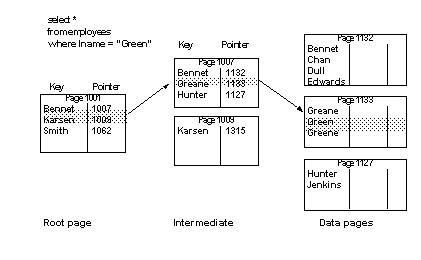To select a particular last name using a clustered index, Adaptive Server first uses sysindexes to find the root page. It examines the values on the root page and then follows page pointers, performing a binary search on each page it accesses as it traverses the index. See Figure 12-1 below.
Figure 12-1: Selecting a row using a clustered index, allpages-locked table

On the root level page, “Green” is greater than “Bennet,” but less than Karsen, so the pointer for “Bennet” is followed to page 1007. On page 1007, “Green” is greater than “Greane,” but less than “Hunter,” so the pointer to page 1133 is followed to the data page, where the row is located and returned to the user.
This retrieval via the clustered index requires:
One read for the root level of the index
One read for the intermediate level
One read for the data page
These reads may come either from cache (called a logical read) or from disk (called a physical read). On tables that are frequently used, the higher levels of the indexes are often found in cache, with lower levels and data pages being read from disk.